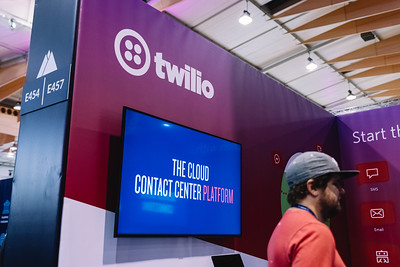Cloud Stocks: Twilio Steps Up Spending For 2020

Twilio (NYSE: TWLO) is a leading player in the Communications PaaS segment that made it to our list of Top 20 Cloud Stocks for 2020. It recently reported a strong quarter that beat estimates but its profitability outlook was disappointing.
Twilio’s Financials
For the fourth quarter of the year, Twilio’s revenues grew 62% to $331.2 million, ahead of the market’s forecast of $315 million. GAAP loss from operations more than doubled to $93.8 million. Non-GAAP earnings was $0.04 per share, in line with analyst estimates.
For the full year 2019, revenue was up 75% to $1.13 billion with $177 million coming from SendGrid since its acquisition in February 2019. GAAP loss from operations more than doubled to $369.8 million. Non-GAAP earnings was $0.16 per share.
Among key metrics, its Q4 base revenues grew 65% over the year to $306.6 million and full year base revenue grew 79% to $1.06 billion. It added 6,908 customers in the quarter to end with 179,000 active customers. Its dollar-based net expansion rate was 132% in the fourth quarter and 136% for the full year.
Revenues from SendGrid grew 30% to $54 million in Q4. Its top 10 active customer accounts accounted for 14% of its total revenues, compared with 20% a year ago and 13% in the last quarter.
For the year 2020, Twilio plans to make significant investments that will affect its profitability. It forecast revenues of $1.475-$1.49 billion for a growth of 30% to 31%, which is a sharp decline from last year’s 75% growth. Non-GAAP operating loss is expected to be $50-$60 million and non-GAAP loss per share is expected to be $0.20 to $0.14.
For the first quarter, Twilio forecast revenue of $335-$338 million at a growth of 44% -45% and a loss of $22 to $25 million. Non-GAAP loss per share is expected to be $0.11 to $0.09.
While the revenue outlook was in line with analyst estimates of $326.7 million for Q1 and $1.46 billion for 2020, analysts were expecting slight profitability of $0.03 per share for the first quarter and $0.23 per share for fiscal 2020.
Twilio’s Offerings
With the help of Twilio Super Network, Verify, Autopilot, TaskRouter, and Interactions API, Twilio has managed to dominate the CPaaS space. Twilio’s offerings focus on four principal areas: Contact centers, two-factor authentication, bots/automation, and omnichannel.
One of its recent offerings that has seen much traction is Flex, a programmable contact center platform that allows developers to easily build contact center channels, routing, and integrations. During the recent quarter, Southwest Airlines signed up for Flex.
Last year, Twilio introduced the Twilio Media Streams API that leverages AI to understand the sentiment of the caller and address issues accordingly. It also announced the addition of Verified SMS by Google to the Twilio Platform, making it possible for its clients to send authenticated and branded SMS to customers on their Android handsets.
In January this year, Twilio launched Be My Eyes, an app to help visually impaired and blind people. Be My Eyes pairs cameras and video chat to help 178,000 visually impaired people get help from over three million volunteers. Its chat function can also be used with specific companies like Microsoft, Google and Lloyds Banking, making it easier for them to get specialist help in using their services, be it for banking, shopping, or booking tickets.
Twilio’s Major Customers
In my recent PaaS post, I refer to Twilio as a case study to avoid lumpy revenues. In 2017, Uber, which accounted for 12% of Twilio’s revenue, suddenly decided to stop using Twilio and move its cloud communications development in-house. Obviously, there’s a lesson to learn from Twilio’s Uber fiasco: it’s better to have 100 clients, each producing a solid chunk of revenue, than one client producing 12%. Twilio now has 179,000 clients and over 5 million developers building apps on its platforms.
Lyft connects the riders with drivers securely using Twilio SMS and offers personalized phone support using a Twilio Flex-powered contact center. Netflix relies on Twilio keep users updated with real-time account notifications and secure their accounts using two-factor authentication. Zendesk uses the Twilio platform to build Zendesk Voice and add conferencing, video, and SMS capabilities. TransferWise uses Twilio’s Programmable SMS and Programmable Voice as well as Authy API for two-factor authorization. Airbnb uses Twilio to automate mobile communication between rental hosts and potential guests using text messaging. UK retail giant Marks and Spencer revamped its contact center with Twilio Flex and has seen a $10M uplift in sales. Twitter built a flexible and scalable phone network for instant rollout across several countries. Other major clients include Foursquare, Morgan Stanley, Intuit, Lendingtree, ebay’s StubHub, Shopify, HubSpot, and MercadoLibre.
During the recent quarter, Twilio announced a new deal with Paypal for its core Twilio platform, enabling new SMS delivery platform.
Twilio has expanded over the years and so has its competition. Its rivals now include Cisco (since its Tropo acquisition in 2015), Vonage (since its $230M acquisition of Nexmo in 2016), Plivo, Bandwidth, MessageBird, 2600Hz, GlobalReach Technology, Sinch, Voxbone, and Cometchat.
Its stock was on an upswing shortly before its earnings but tumbled 7% following the disappointing outlook. Its stock is currently trading at $122.21 with a market cap of $16.7 billion, up 36% from its 52-week low of $89.81 nearly a year ago. It touched a 52-week high of $151 in July.
Given the focused execution of Twilio, I believe it looks promising in the long-term. Profitability will follow.
Photo Credit: Web Summit/Flickr.com
Sramana Mitra is the founder of One Million by One Million (1M/1M), a global virtual incubator that aims to help one million entrepreneurs ...
more


